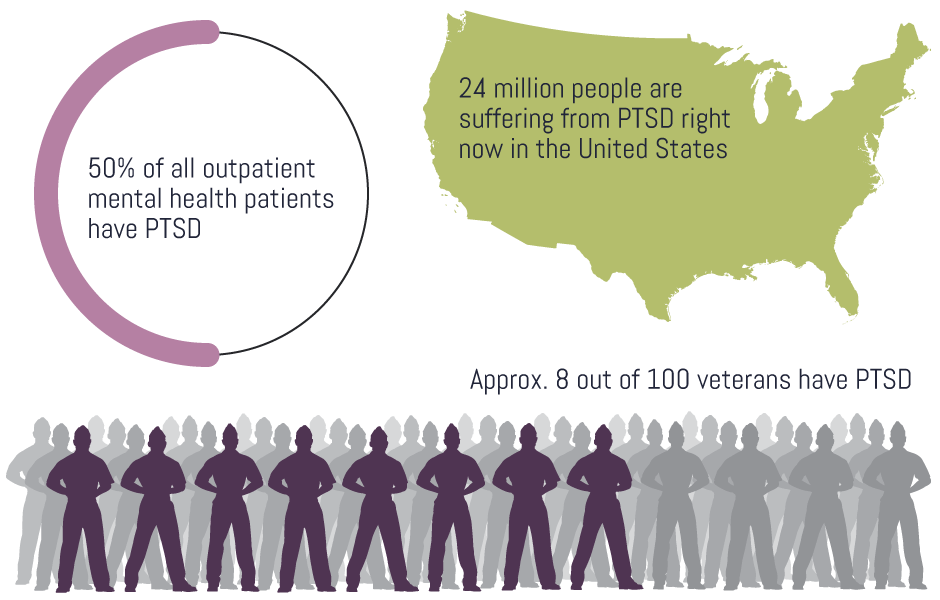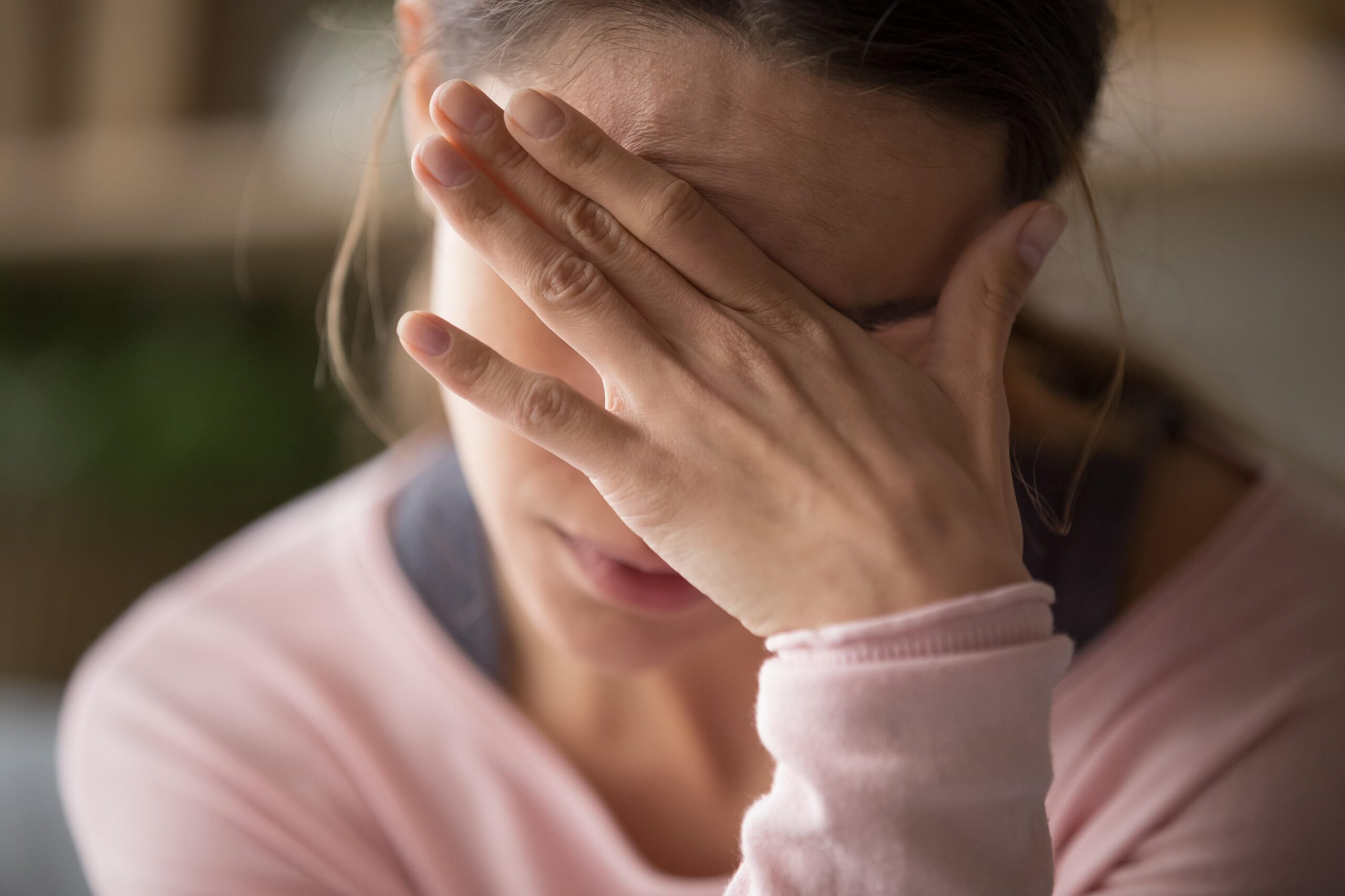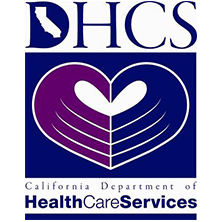Substance Abuse Coercion
Even if Safe Harbor Treatment Centers is not the right fit for you, for whatever reason, we encourage you to call our team of professional advisors to help you find the Treatment Center that will help you get sober.
With over twenty years in the field, we have relationships with the top facilities in the world and can direct you to a program that fits your financial, spiritual and therapeutic needs. Getting sober is not a one-size-fits-all experience, and you don’t have to do it alone. We can help you ask the right questions, so that you can find the right place.
We are here 24 hours a day, seven days a week. Call us at (877) 978-2146
PTSD (post-traumatic stress disorder) affects about 45 million people in the United States today.1 Women are about twice as likely as men to develop PTSD. The socioeconomic cost to our society is tremendous due to PTSD where it is estimated that:
- People with PTSD have among the highest rates of using healthcare services
- The cost of PTSD-related anxiety disorders is more than $42.3 billion annually
- PTSD affects adults as well as children
- Approximately 50% of all outpatient mental health patients have PTSD
- Approximately 24 million people are suffering from PTSD right now in the United States
- The risk for PTSD is much higher in war veterans.2 Approx. 8 out of 100 veterans have PTSD.(3)
Intrusive Thoughts
Intrusive thoughts can plague people with PTSD. Flashbacks, where you repeatedly relive the trauma, occur. Physical symptoms happen just as they did during the original ordeal, such as sweating or elevated heart rate. Terrifying thoughts intrude during the day and nightmares invade your sleep.
Avoiding Reminders of the Traumatic Event
The symptom of avoidance happens when you steer clear of any places, objects, or events that are reminders of the traumatic ordeal. Also, avoiding thoughts or feelings related to the traumatic experience can occur. Avoidance can affect daily life, causing you to change your routine.
Negative Thoughts and Feelings
Negative thoughts and moodiness can occur with PTSD. Negative thoughts may include guilt, blame, and bleak feelings about oneself or society. You may lose interest in activities you once found enjoyable. Trouble remembering key features of the traumatic encounter is also a common symptom. All these feelings and thoughts can lead to detachment and alienation from loved ones.
Arousal and Reactive Symptoms
Arousal and reactivity symptoms include tenseness, being easily startled, insomnia, and anger. Arousal symptoms are typically always present, rather than being triggered by traumatic event reminders. These symptoms can make it hard to accomplish daily activities such as concentrating, eating, and sleeping.
Working all the Time to Occupy Your Mind
You start to work much more than before the trauma event to occupy your thoughts to avoid intrusive or negative thoughts from taking hold.
Isolation
If you feel unable to relate to other people, or that people don’t seem to understand how you can’t shake the symptoms from a trauma, you may isolate yourself. Isolation helps you avoid uncomfortable feelings that arise when you are with others.

Sexual Violence
One common cause of PTSD is experiencing sexual violence or assault as a child or as an adult. Any form of sexual contact that occurs without an adult’s consent or that violates a child’s or adult’s sense of control, autonomy, and command over their own body can cause PTSD.
Military Service
Throughout the 20th century, soldiers who suffered lasting mental health effects after combat were deemed to be “shell-shocked” or “battle fatigued”. We now recognize these conditions as being PTSD that comes from being in traumatizing combat events.
Natural Disaster
People who experience stressful natural disaster events such as hurricanes, fires, earthquakes, tsunamis, and tornadoes can feel overwhelmed at the sudden devastation they experienced. The initial shock can then become PTSD.
Traffic Accident
Traffic accidents happen suddenly with little or no warning. The trauma associated with a crash can lead to PTSD, particularly if the person has had past trauma(s), if the traffic accident was life-threatening, or if the person has other mental health conditions.
Serious Injury
An experience that causes serious injury can bring shock and horror. The physical consequences and psychological aftereffects can contribute to the onset of PTSD.
You may be experiencing PTSD if you have a cluster of emotional symptoms, which include:
Anxiety: You’re constantly anxious that there may be danger around you
Anger: You lash out in anger for no apparent reason
Depression: You feel depressed due to misplaced guilt
Irritability: You are frequently irritable or moody
Sadness: You often feel sad for no apparent reason
Physical
Physical symptoms can manifest with PTSD, including:
Fatigue: You feel tired all the time
Increased perspiration: You sweat a lot more than you did prior to the traumatic event
High or low blood pressure: Your blood pressure is either above or below normal
Digestion issues: You often find it hard to digest food
Some factors that increase risk for PTSD include:
• Surviving a dangerous event and trauma
• Childhood trauma
• Getting injured
• Seeing another person injured
• Seeing a dead body
• Feeling scared, helpless, or experiencing extreme fear
• Added stress after the trauma experience, such as injury or loss
• Experiencing little or no social support after the traumatic event
• Having a mental illness or substance abuse history
• Finding support after a traumatic experience
• Searching out support from loved ones
• Having positive coping skills to get through the trauma and learning from it
• Learning to feel competent about your own actions when facing danger
• Being able to respond competently despite fear
Currently, people with PTSD are treated with medications and psychotherapy. Since everyone is affected differently from PTSD, treatment must be designed for the particular person, because what may work for one person may not work well for another.
If you have PTSD, it’s important you seek help from a mental health professional who has experience treating this disorder. You may have to try several different treatments to find what works best for you. If you have other issues, such as ongoing trauma, depression, or substance abuse, you’ll need to treat all the co-occurring issues at the same time for effective recovery.
There are other types of treatment for PTSD, and you can discuss these options with your therapist. Effective treatment should help you manage your symptoms and get you back on track to the way you were before the trauma.
Medication has been proven to be an effective treatment for PTSD. According to the National Center for PTSD, 42 out of 100 people who take medication will no longer meet the guidelines for PTSD.(3) Medications may be prescribed along with psychotherapy. Medications that effectively treat PTSD include:
Antidepressants: To reduce sad feelings, anger, numbness, and worry
Alpha-adrenergic Blockers: To help regulate blood pressure and relieve nightmares
Anti-anxiety medications: Short-term use of these drugs can help relieve severe anxiety
Psychotherapy, also known as talk therapy, can help PTSD sufferers work through the trauma. According to the National Center for PTSD, 53 out of 100 people who receive PTSD psychotherapy treatment will no longer meet the guidelines for PTSD.(3)
Psychotherapy involves talking with a mental health professional regarding a mental health disorder like PTSD. Psychotherapy can be conducted on an individual basis or within a group. Treatment sessions typically run from 6 to 12 weeks, but can go longer when needed. You’ll learn about trauma and its effects, relaxation techniques, anger control, and how to live a healthier lifestyle.
Psychotherapy can help people with PTSD by addressing the symptoms directly or by focusing on PTSD-related problems. Mainly, therapy sessions include PTSD education, learning skills to help identify symptoms triggers, and how to manage symptoms.
Exposure therapy, a form of CBT (cognitive behavioral therapy) can help you confront and control your fear. You’ll be slowly and safely exposed to the trauma. Methods used to do this are writing, imagining, or visiting the place where the event occurred. Your therapist uses these methods to teach you coping skills.
There are other types of treatment for PTSD, and you can discuss these options with your therapist. Effective treatment should help you manage your symptoms and get you back on track to the way you were before the trauma.
Cognitive Restructuring
Cognitive restructuring is another form of CBT that helps you process the bad memories from a traumatic experience. You may remember the event differently from what happened. Consequently, you may feel guilty or shameful over things that occurred that were not your fault or that you had no control over. Your therapist will help you examine the incident in a rational way.
Misconception: PTSD only happens in the military
War veterans are seriously affected by PTSD, but they are not the only segment of the population that’s affected. Even children can get PTSD, and it can happen to anyone at any age.
Misconception: PTSD happens right after a traumatic ordeal
Typically, PTSD symptoms start about 3 months after a trauma. In many cases, the symptoms begin many months or years later. For some, symptoms are continuous, and for others they appear, disappear, and then reappear. If symptoms don’t occur right after an event, it may be hard for the person to make the connection between the symptoms and the trauma.
Misconception: People who have PTSD should just snap out of it
Some people readjust after a traumatic ordeal, but others can’t, and this has nothing to do with mental weakness. There are many factors that determine if someone will get PTSD, such as the type, severity, and the length of the traumatic ordeal, the individual’s personality, the way the brain releases stress chemicals, and if the person had past trauma or has a solid support network.
There are steps you can take outside of treatment to help yourself deal with PTSD. While it may be difficult, with treatment and your own management, you can recover.
You can also care for yourself by:
• Letting a trusted friend or relative know what you are experiencing
• Letting those around you know what may trigger PTSD symptoms
• Doing gentle physical activities or exercises to release stress
• Setting realistic goals for yourself
• Breaking up tasks into smaller, more manageable ones.
• Trying to spend time with friends or family
• Identifying and going to places or being with people you feel comfortable with
• Reducing or eliminating caffeine and nicotine intake as they can worsen anxiety
• Avoiding self-medication with drugs or alcohol to cope
• Giving yourself time to recover, it doesn’t happen immediately
Service animals, most commonly dogs, can give you positive emotional benefits that help treat your PTSD. A dog in your home can boost your mood and relieve your stress. The companionship your dog provides can be fun and loving. Walking your dog can be a good source of regular exercise and fresh air. When you’re out with your dog, it can be a great way to meet new people.
RESOURCES
- http://www.ptsdunited.org/ptsd-statistics-2/
- http://www.namiarizona.org/page17/page34/index.htmlhttps://www.ptsd.va.gov/
- https://www.ncbi.nlm.nih.gov/pmc/articles/PMC3811127/
- https://www.ncbi.nlm.nih.gov/pmc/articles/PMC2760665/
- https://www.ncbi.nlm.nih.gov/pmc/articles/PMC4346088/
- https://www.ncbi.nlm.nih.gov/pmc/articles/PMC4579516/
- https://www.ncbi.nlm.nih.gov/pmc/articles/PMC4518698/




